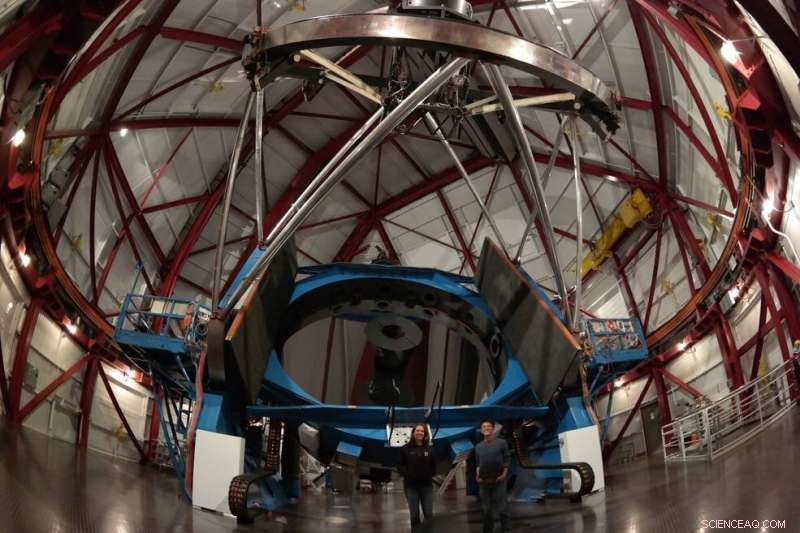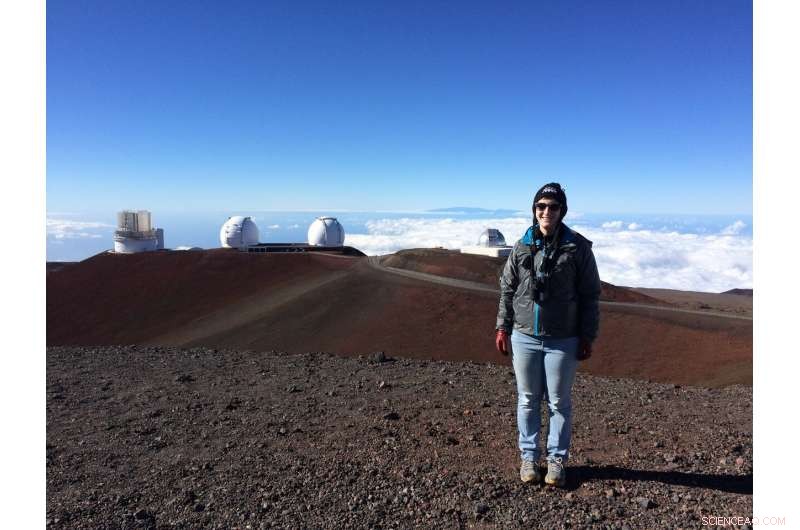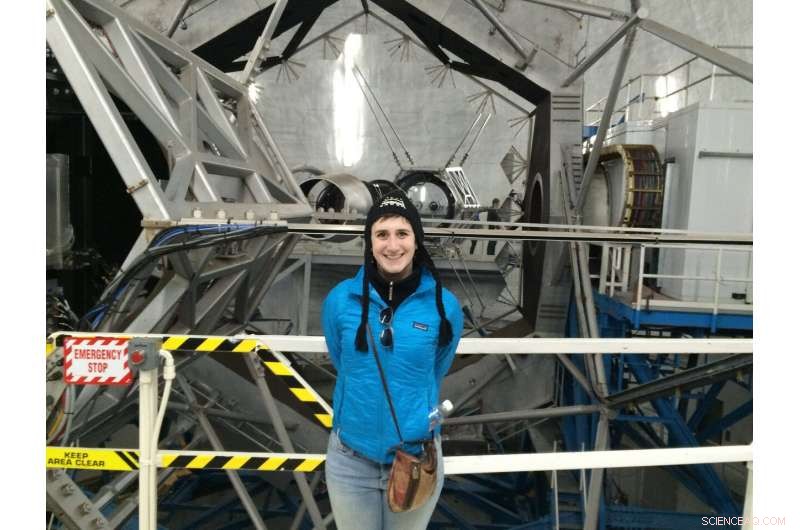
Les astronomes Johanna Teske et Alex Ji au télescope Magellan II au Chili. Crédit :Cindy Hunt
Alors qu'un liquide rose suintait autour de ses chaussures, l'astronome Johanna Teske a commencé à se sentir malade. Elle cherchait de nouvelles planètes avec le spectrographe Planet Finder, un instrument astronomique ressemblant à un réfrigérateur de taille industrielle monté sur le télescope Magellan II. Une nuit en octobre 2018, un tuyau menant à l'instrument a éclaté, provoquant le déversement de liquide de refroidissement rose sur les parties sensibles de l'instrument et la plate-forme environnante. La recherche de Teske serait-elle ruinée ?
Teske utilise le télescope Magellan II de l'observatoire de Las Campanas au Chili pour localiser les planètes en dehors de notre système solaire, ou exoplanètes, et découvrez de quoi ils sont faits. À ce jour, plus de 4, 000 exoplanètes ont été découvertes, mais la science a montré qu'il doit y avoir des milliards, voire des milliards, dans notre galaxie seulement. Le plus récent chasseur de planètes de la NASA, le Transiting Exoplanet Survey Satellite (TESS), recherche des planètes possibles autour d'étoiles brillantes proches.
De nombreuses équipes de scientifiques du monde entier passent actuellement au peigne fin les données TESS, choisir des étoiles qui pourraient être prometteuses à observer depuis le sol et réserver du temps dans de puissants télescopes pour suivre les nouvelles planètes candidates. La course est lancée pour voir lequel de ces signaux TESS représente une sorte d'imposteur, et qui pointent vers de vrais nouveaux mondes.
En tant que boursier postdoctoral Hubble de la NASA aux observatoires Carnegie de Pasadena, Californie, Teske était ravi de participer à cette course. Son groupe a reçu un financement de la NASA pour rechercher des planètes avec trois fois le rayon de la Terre ou moins, qui inclurait des planètes excentriques appelées "super-Terres". On pense que les super-Terres sont rocheuses comme la Terre, mais légèrement plus gros que notre planète. En octobre 2018, Teske et ses collègues ont commencé les observations de suivi TESS pour la première fois. Mais vers le milieu de leur course de deux semaines, pendant leur nuit la plus claire, le tuyau a éclaté.
Le tuyau pourrait-il être réparé et le désordre nettoyé assez tôt pour économiser le reste du temps d'observation de Teske ? Est-ce qu'elle et son équipe recueilleraient des données précieuses sur les exoplanètes ?
Pourquoi la chasse aux planètes depuis la Terre est essentielle
La nuit dramatique de Teske au Chili n'est pas typique, mais illustre comment la recherche d'exoplanètes depuis le sol peut être compliquée par des préoccupations terrestres. Outre le problème mécanique occasionnel, les astronomes doivent lutter contre le vent, pluie, neiger, les nuages et les turbulences atmosphériques générales, qui pourraient gâcher une nuit entière d'observation du ciel. La Lune présente également des défis :alors que les étoiles TESS sont généralement brillantes et peuvent être observées pendant les « heures claires », c'est-à-dire lorsque la Lune est pleine aux trois quarts environ, les astronomes qui observent des étoiles très faibles ou d'autres galaxies doivent attendre le « temps sombre » lorsqu'il y a peu ou pas de clair de lune. Et, puisque les astronomes ne peuvent observer que la nuit, ils doivent renoncer au sommeil pendant les heures d'obscurité précieuse.
Mais les télescopes au sol sont essentiels pour confirmer l'existence des planètes trouvées par TESS et d'autres télescopes spatiaux, et pour en savoir plus sur eux. TESS, comme le chasseur de planètes basé dans l'espace Kepler, dont la mission a pris fin en 2018, fixe les étoiles sur des périodes de temps, mesurer la luminosité de l'étoile toutes les quelques minutes pendant des semaines à la fois. Une baisse de cette luminosité pourrait représenter un événement appelé « transit, " dans laquelle une planète passe devant son étoile. Mais le pendage pourrait tout aussi bien provenir d'une autre étoile, ou être un autre type de phénomène transitoire se produisant sur l'étoile ou dans l'électronique du détecteur.
Les scientifiques doivent se tourner vers des télescopes au sol pour comprendre cela. Lorsque Kepler renvoyait des données suggérant des milliers de nouvelles planètes, les astronomes se sont organisés pour les suivre, trop. Les résultats ont permis de réaliser qu'il y a plus de planètes que d'étoiles dans la Voie lactée.
"Les mesures de luminosité du vaisseau spatial ne sont que la première étape, " a déclaré David Ciardi, astronome au California Institute of Technology, Pasadéna. « Vous avez besoin d'un programme au sol dédié pour vérifier et clarifier ce que vous voyez. Sans les données au sol, vous ne pouvez pas comprendre ce que TESS a vu."
Dans certains cas, there may be data collected from a star in years past that contain the information necessary to confirm a planet candidate—such as in the case of TESS's first confirmed planet Pi Mensae c. Autrement, astronomers need fresh observations to learn all they can about these alien worlds.
And because they are accessible to human hands, ground-based telescopes can be upgraded, fixed and re-tooled much more easily than space observatories. Dans certains cas, ground-based telescopes have higher resolution for taking images of stars than space telescopes.
"We have a lot of questions about every single planet, " said Lauren Weiss, the Parrent Postdoctoral Fellow at the University of Hawaii at Manoa. "There are a lot of small planets that we're really excited about, but in order to answer all of these questions, we have to use a variety of new tools and techniques."

Astronomer Lauren Weiss at the W. M. Keck Observatory in Hawaii. Credit:B.J. Fulton
Ground-based follow-up is more critical than ever now that astronomers are gearing up for NASA's upcoming James Webb Space Telescope, which will study exoplanet atmospheres with greater sensitivity than any observatory yet. Webb will look for the fingerprints of chemicals in exoplanet atmospheres, including those allowing life as we know it to thrive. But because Webb will target many different scientific questions about the universe, it will only have a portion of its time for looking at exoplanets. Astronomers need to start finding the most promising targets now so that they're ready to explore them further as soon as Webb starts operating.
But first, scientists need to be sure those planets are really there.
What Ground-Based Telescopes Do
One of the first facts a scientist needs to know about a possible exoplanet is:Which star does the planet orbit? This fundamental puzzle piece isn't immediately obvious from telescope data because all astronomers can see are individual pixels from the telescope camera, each corresponding to an area of the sky. If two stars appear extremely close to each other in these data, it may not be obvious which star seems to be dimming because of a transiting planet.
"The ground-based efforts can determine which star is the source of the signal, " said Knicole Colon, astronomer at NASA's Goddard Space Flight Center in Greenbelt, Maryland. "That's absolutely a major part of the ground-based follow-up:Which star is the host?"
Puis, there's a separate process of getting the mass of the planet. No one can put a planet on a scale. But a planet's mass is often determined through the "radial velocity method", or looking at how the star wobbles ever so slightly in response to the gravity of its planets. Currently, only ground-based telescopes are capable of exoplanet radial velocity measurements. Carnegie's Planet Finder Spectrograph, which Teske uses at Las Campanas in Chile, is just one instrument that can determine a planet's mass. The forthcoming NEID spectrograph, a collaboration between NASA and the National Science Foundation, at Kitt Peak Observatory in Arizona, is another example.
The mass of a planet is different from its size, which refers to its diameter. Scientists measure diameter by looking at how much the brightness of the host star dims during the transit.
Combining the size and the mass of the planet, scientists can determine its density—a big indicator of whether it is rocky, like Earth, gaseous, like Jupiter, or something in between, which would be unlike any of the planets we have in our solar system.
Astronomers also use Earth-based telescopes to thoroughly study the stars themselves to determine planet properties. Any size or mass measurement of a planet can only be calculated relative to the size and mass of its host star. And if the star is part of a double-star or multi-star system, that could change the calculations entirely unless astronomers can determine the fraction of light originating from other nearby stars, and factor it into their calculations.
With so many different properties of star and planet observations to consider, it often takes large groups of scientists working with different instruments to arrive at even a basic understanding of a planetary system.
"That's why these teams are so big, " Weiss said. "Each of us has to address a very specific question, or set of questions, related to the validity of the planetary hypothesis, and the fundamental properties of the star and planet."
A planet that Weiss helped discover, TOI-197b (also called HD 221416b), is a particularly good example of how a giant collaboration of people using observatories in space and on the ground can paint a picture of a new world. The study announcing it to the world, published in April 2019, was authored by more than 100 people representing five different continents. Astronomers found out a lot about the age and radius and mass of the star because of the special way they have been able to examine its properties.
"The star is ringing like a bell from internal pressure waves and gravity waves inside the star, " Weiss said. The study of these waves, called asteroseismology, is a powerful tool for characterizing a star.

Astronomer Lauren Weiss looks at planets outside our solar system using the Keck Telescope in Hawaii. Credit:B.J. Fulton
Multiple observatories worldwide including Keck Observatory at Mauna Kea in Hawaii, where Weiss was situated, contributed observations. Dan Huber, l'auteur principal, wrangled all of the different datasets together. Ashley Chontos at the University of Hawaii created a model to reconcile both the transit and radial velocity measurements. By matching their model to the observations, astronomers were able to put together a picture of the planet that could explain all of these different signals seen in all of the different telescopes.
Astronomers found that, at 63 times the mass of Earth, this planet is a little bit denser than Saturn. But they call it a "hot Saturn" because its orbit around its star is only 14 days (by contrast, Saturn makes a loop around our Sun every 29 years). There is nothing quite like it in our solar system.
A New Planet, and Even Another
Donc, what happened with Teske's planet search after the burst pipe incident at Las Campanas? The search for new planets motivated her to snap into action. "Pretty quickly I moved into 'how do we fix' this mode, " she recalled. "It was a big team effort for sure."
Heureusement, the observatory staff was able to resolve the issue in a few hours. After they finished mopping and carefully checked over the instrument, Teske and colleagues resumed their exploration of exoplanets that very night, and continued for the rest of their scheduled week. Despite overnight observing for about two weeks during the telescope run, Teske didn't go home to Pasadena afterwards—she boarded a plane for Washington, D.C., where she ran a marathon.
Their observations from that trip helped scientists determine the mass of a planet around a star called HD 21749 or GJ 143. This so-called "sub-Neptune" planet is about 2.6 times the diameter of Earth and likely gaseous, but smaller than any gas giant in our solar system.
Combining the Las Campanas observations with data from TESS and archival data from the HARPS instrument at La Silla, Chili, astronomers were able to confirm this exoplanet and determine its mass, which is more than 20 times that of Earth.
"While we were looking at the data for that planet, we found that there is another planet in the same system around the same star; it's about Earth's size, " said Diana Dragomir, also a NASA Hubble Postdoctoral Fellow at MIT who was the first author on a study of this system, and part of the observing team with Teske at Las Campanas. "It's a nice demonstration that TESS can indeed find Earth-size planets."
During the same observing run, Teske and colleagues also got some measurements of Pi Mensae c, the very first planet confirmed in TESS data, that may help get a better handle on its mass. With more data left to sift through, discoveries may be yet to come from that same observing run in October 2018.
Since TESS recently turned its gaze to the northern hemisphere of the sky, the Chilean telescopes will be out of range for much of the next batch of data. That gives Teske and collaborators time to go back through what they've done so far, and figure out which southern TESS stars they want to keep following over the next two years. Their goal is to find out more about super-Earth and sub-Neptune exoplanet populations by establishing masses for such planets as precisely as possible.
At nearly 8, 000 feet up, Las Campanas isn't high enough to make Teske feel dizzy from the altitude, but high enough that she might get out of breath from walking fast. A variety of wildlife, like foxes and rabbit-like animals called viscachas, sometimes approach the dome as Teske and her collaborators explore the galaxy. She knew she wanted to be an astronomer around age 10 or 11 when she saw the movie "Contact, " based on the book by Carl Sagan, and related to the main character's drive and curiosity. Aujourd'hui, observing in Chile is one of Teske's favorite parts of her job.
"I am getting to see things that no one else is seeing. It's quiet, and it's just me and the stars, " Teske said. "I hesitate to use the word 'magical'—but it's analogous to that."